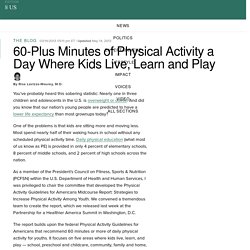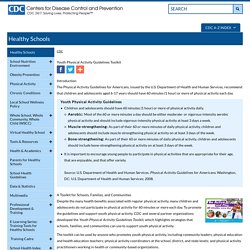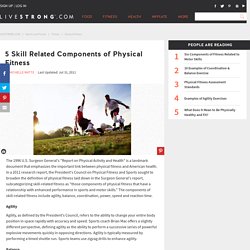

60 Minutes a Day. 60-Plus Minutes of Physical Activity a Day Where Kids Live, Learn and Play. You’ve probably heard this sobering statistic: Nearly one in three children and adolescents in the U.S. is overweight or obese.

And did you know that our nation’s young people are predicted to have a lower life expectancy than most grownups today? One of the problems is that kids are sitting more and moving less. Most spend nearly half of their waking hours in school without any scheduled physical activity time. Daily physical education (what most of us know as PE) is provided in only 4 percent of elementary schools, 8 percent of middle schools, and 2 percent of high schools across the nation. As a member of the President’s Council on Fitness, Sports & Nutrition (PCFSN) within the U.S. The report builds upon the federal Physical Activity Guidelines for Americans that recommend 60 minutes or more of daily physical activity for youths.
So, what did we learn? Happily, there are places where this is already happening. Yet there is a lot more work to be done, and we all have a role to play. Youth Physical Activity Guidelines. Skip directly to search Skip directly to A to Z list Skip directly to navigation Skip directly to page options Skip directly to site content Get Email Updates To receive email updates about this page, enter your email address: Related Links Healthy Youth Youth Physical Activity Guidelines Toolkit Recommend on Facebook Tweet Introduction The Physical Activity Guidelines for Americans, issued by the U.S.

Youth Physical Activity Guidelines Children and adolescents should have 60 minutes (1 hour) or more of physical activity daily. A Toolkit for Schools, Families, and Communities Despite the many health benefits associated with regular physical activity, many children and adolescents do not participate in physical activity for 60 minutes or more each day. Toolkit Components Many of the toolkit components can be adapted and customized for various audiences.
Ordering Information Related Resources File Formats Help: How do I view different file formats (PDF, DOC, PPT, MPEG) on this site? Top. Health Components of Fitness. Health Related Components of Fitness. Skill Components. 5 Skill Related Components of Physical Fitness. The 1996 U.S.

Surgeon General's "Report on Physical Activity and Health" is a landmark document that emphasizes the important link between physical fitness and American health. In a 2011 research report, the President's Council on Physical Fitness and Sports sought to broaden the definition of physical fitness laid down in the Surgeon General's report, subcategorizing skill-related fitness as "those components of physical fitness that have a relationship with enhanced performance in sports and motor skills.
" The components of skill-related fitness include agility, balance, coordination, power, speed and reaction time. Agility, as defined by the President's Council, refers to the ability to change your entire body position in space rapidly with accuracy and speed. Sports coach Brian Mac offers a slightly different perspective, defining agility as the ability to perform a successive series of powerful explosive movements quickly in opposing directions. Lose Weight. Remember to Exercise.